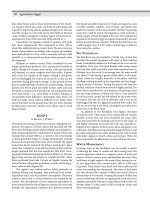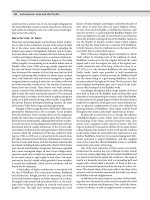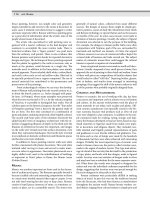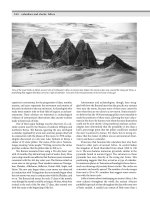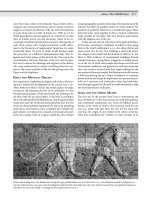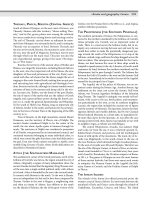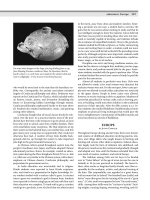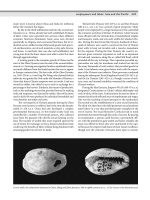Encyclopedia of society and culture in the ancient world ( PDFDrive ) 655
Bạn đang xem bản rút gọn của tài liệu. Xem và tải ngay bản đầy đủ của tài liệu tại đây (53.69 KB, 1 trang )
604
inventions: The Americas
As textile artists, ancient Americans were great innovators. Peruvians and Bolivians began using looms for weaving sometime in the second or third millennium b.c.e. and
pioneered a staggering range of textile techniques, including
simple warp-and-weft weaves, scaffold weaving (discontinuous warp-weft), single-needle knitting, and a host of other
demanding ways of weaving and decorating cloth. These
textiles of animal hair and domesticated cotton were used by
ancient Americans for clothing, shelter, wrapping the dead,
decoration, and furnishings, and they were even used as
containers. Even tie-dyed textiles, a kind of cloth associated
with southern Asia today, were produced in the Americas by
the ninth century b.c.e. The use of woven containers among
Amazonians may have inspired their clever invention of the
hammock, a swinging bed suspended off the ground between
two trees or posts.
In the later part of the Pre-Classic period (nearing the
start of the Common Era) the Maya civilization developed
a full-fledged calendar system. Since the second millennium
b.c.e. early Maya astronomers and their Zapotec and Olmec
contemporaries had followed the movements of the sun, moon
and Venus and had come to mark time by the movements of
these celestial bodies. They invented three separate calendars
to trace and regulate the lives, agricultural activities, dynasties, and mythic sagas of their civilization. The first was a
365-day haab, or solar year (much like our modern calendar),
made up of 18 months. There was also a 260-day tzolk’in, or
cycle of religious ceremonies and festivals, with each day assigned its own name and ritual significance. Finally, a great
era or Calendar Round was celebrated every 52 years at the
coincidence of the other two calendars. The Calendar Round,
functioning much like the Gregorian century, was a large period used by historians and some religious leaders to mark
ages, the return of rare celestial events, dynastic changes, cultural trends, and even the fulfi llment of prophecies.
Many modern sports were born of early antecedents in
the ancient Americas. Most notable of these sports is basketball, which was a ceremonial game played by religious
devotees in eastern Mexico from about 1000 b.c.e. The very
possibility of the bouncing ball originated in another Mesoamerican invention, that of vulcanized rubber. Both the rubber and sapodilla trees of eastern Mexico produce latex. The
Mesoamericans were the first to put latex to use as a sealant
and sculpture material. The Olmec developed the process of
vulcanizing rubber, whereby it was heated to make it more
malleable so the material could be fashioned into any shape
desired. Thus, the ancient Olmec civilization contributed one
of the most important materials to the development of the
modern world.
There is evidence that soccer and football also existed
in early versions among the ancient Mesoamericans as ritual games played at religious ceremonies. Both field and ice
hockey have ancient origins in early versions of shinny, a
sport played in the North American Great Plains region up to
European colonial times.
The early urban centers of the Andes date back as far as
the third millennium b.c.e. Many early cities such as Caral
and Kotosh feature centrally located plazas, sunken courtyards, and pyramidal temples. The adobe pyramids at Caral
and El Aspero in Peru were built around 3000 b.c.e., several
centuries before the stone ones in Egypt. The ancient Olmec
employed outdoor and indoor plumbing to conduct water
through their cities. They installed carved canal blocks in
three- to five-foot lengths to create aqueducts centuries before the Romans or Maya employed similar concepts in their
urban centers. The so-called New Temple at Chavín de Huantar in Peru also shows knowledge of aqueduct technology.
The Chavín culture of the first millennium b.c.e. employed conduits for air as well as water in a fully functioning hydraulic system that drew both substances into the New
Temple. This design created a constant roar of running water
and a steady circulation of air that is still functioning today.
Indeed, Native American structures from ancient Chavín’s
temple complex to medieval-era cliff dwellings in Arizona all
employ ventilation concepts pioneered sometime in the first
or second millennium b.c.e.
In their use of durable, carved basalt aqueducts, the Olmec showed a mastery of stonemasonry, which they seem to
have developed to a fine point by 1000 b.c.e. Later civilizations in both Mesoamerica and South America, who had little
contact with the Olmec civilization, also became well known
for their stonemasonry, which suggests that this inventive engineering was developed in several places independently. The
Late Pre-Classic Maya (400 b.c.e.–250 c.e.) adapted earlier
stonemasonry to their own needs, adding a stone and lime
compound that Romans, who were inventing it at roughly the
same time, would call concrete. The early Maya also developed a softer mortar, now called stucco, that they carved into
beautiful designs on their palaces and temples.
Many hunting tools were invented by early Americans
to support a lifestyle that was far from sedentary. Detachable
harpoon points from the Northwest Coast North Americans
and fluted arrow points from the Clovis culture allowed whalers and hunters to fire at their prey and then get out of the
animal’s way as it rampaged. The weapons were carefully recovered from the dead animal by the fisherman or hunter. By
sea, river, and estuary, ancient Americans also became master fishers in their canoes, kayaks, or reed or skin boats, all
invented in ancient times. Combining efficient weapons and
watercraft with woven fishing nets and waterproof garments,
ancient Americans invented an almost modern ensemble of
fishing apparatuses.
American agriculture was apparently in progress by the
seventh millennium b.c.e. By the second millennium b.c.e.
a full range of farming techniques existed in the Americas,
from terraced fields to desert, swamp, and jungle plantations. Some scientists believe ancient Americans may have
loosely tailored certain North and South American forests to
increase the density of food sources, modifying established
forests. The ancient Americans exhibited some of the world’s
